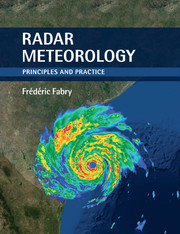Book contents
- Frontmatter
- Dedication
- Contents
- Preface
- Notation
- 1 Meteorology and radar
- 2 Fundamentals of weather radar measurements
- 3 Radar reflectivity and products
- 4 Reflectivity patterns
- 5 Doppler velocity information
- 6 The added value of dual polarization
- 7 Convective storm surveillance
- 8 Monitoring widespread systems
- 9 Radar estimation of precipitation
- 10 Nowcasting
- 11 Additional radar measurements and retrievals
- 12 Cloud and spaceborne radars
- 13 What does radar really measure?
- Appendix A Mathematics and statistics of radar meteorology
- References
- Index
6 - The added value of dual polarization
Published online by Cambridge University Press: 05 June 2015
- Frontmatter
- Dedication
- Contents
- Preface
- Notation
- 1 Meteorology and radar
- 2 Fundamentals of weather radar measurements
- 3 Radar reflectivity and products
- 4 Reflectivity patterns
- 5 Doppler velocity information
- 6 The added value of dual polarization
- 7 Convective storm surveillance
- 8 Monitoring widespread systems
- 9 Radar estimation of precipitation
- 10 Nowcasting
- 11 Additional radar measurements and retrievals
- 12 Cloud and spaceborne radars
- 13 What does radar really measure?
- Appendix A Mathematics and statistics of radar meteorology
- References
- Index
Summary
Why polarization matters
Operational weather radars have been undergoing another massive transformation. In addition to making reflectivity and Doppler velocity measurements, they are now collecting data at more than one polarization. This opens the possibility of measuring several dualpolarization quantities that can then be used in a variety of applications. Detailed treatment of the physics and the use of such quantities can be the subject of entire books, for example, Bringi and Chandrasekar (2001). In this chapter, only a brief introduction of some of the ideas behind multiple linear polarization measurements and of their applications is presented.
Virtually all man-made emissions of radio waves and microwaves are polarized. Most single-polarization weather radars transmit linearly and horizontally polarized EM waves (Fig. 6.1a). In the context of a wave traveling in the x direction in a (x, y, z) space, for such single-polarization radars, the electric field oscillates horizontally (in the y direction) while the magnetic field oscillates vertically (in the z direction). Hence, both the electric and magnetic fields oscillate perpendicular to the direction of propagation, assumed horizontal in this discussion. In contrast, most dual-polarization radars transmit waves at horizontal as well as at vertical polarizations, either alternatively or more often simultaneously.
Why is the polarization of the radar wave important? The interaction of the EM wave with hydrometeors and other targets occurs via the electric field of the wave, as the electric field in air induces a field in the hydrometeor. But the field in the hydrometeor will travel slower than that in air because of the higher refractive index. It is initially along the same axis as the wave in air but is then somewhat modified by the shape, size, and refractive index of the hydrometeor. The field inside the hydrometeor then interacts back with the field in air. This interaction has three results (Fig. 6.1b): (1) a partial reflection of the wave with a larger or smaller delay with respect to what would be expected for an idealized point target; (2) a partial attenuation of the transmit wave propagating forward because of loss of power from the reflection as well as from absorption; and (3) an additional delay of the forward propagating wave compared with what would have occurred in the absence of a target.
- Type
- Chapter
- Information
- Radar MeteorologyPrinciples and Practice, pp. 92 - 114Publisher: Cambridge University PressPrint publication year: 2015



